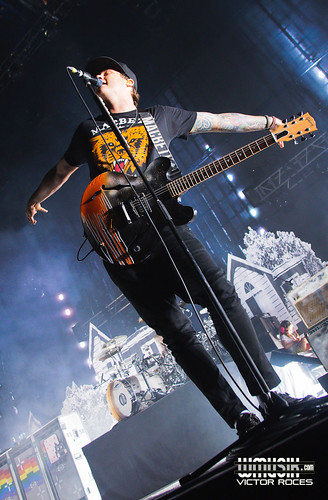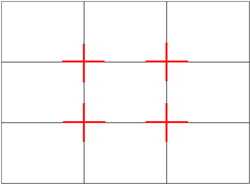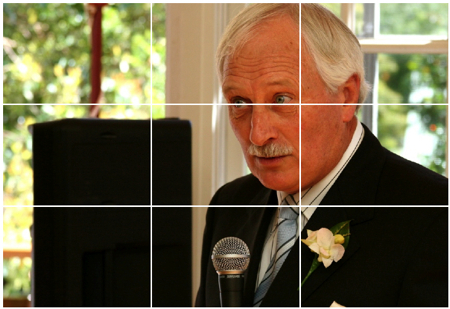VibratoPress will have very broad target audience, as my school magazine features artists from the 1970's to the present day - this will result in a target audience of people possibly around 16-50 years old who are interested in the rock genre. Using artists from a wide timeline will give the magazine the opportunity to receive the biggest target audience, including older and younger people. The target audience within the age range could predominantly be male, but VibratoPress will strive to attract a female audience (resulting in a possible 65:35 percentage ratio); this could be done by featuring female artists or bands within the magazine. According to research, Rock is a skewed genre towards males. However, VibratoPress will strive to include artists in which appeal to a female audience. The jobs of the target audience could be anything, as the genre doesn't influence the occupation of the potential buyer. The hobbies of the potential target audience could include bands, exposure to new music, concerts, gigs and possibly instruments - as well as physical hobbies such as going to the gym and other methods of exercise. I believe that all of these hobbies link to my target audience and make up most of their personality. This may influence the interests of the target audience, which could include a range of things; such as: cars, fashion, instruments (particularly that used in rock) etc.
How the audience may dress may suggest their interest in the genre, such as wearing black clothes. Certain features similar to this link to the key ideas of target audience, which includes the purchase of music (whether that's via iTunes, or streaming via Spotify) in formats which could be either physical or digital. The social networks of my target audience could be all mainstream platforms in which their favourite bands/artists are on, this could be Twitter, Instagram, Facebook and even Snapchat - all of these social networks are ways my target audience interact and connect with their favourite bands. Festivals make up a big part of the rock culture, with several concerts and festivals ran all over the world annually; these include festivals such as Hellfest, the Reading Festival and Glastonbury. Since my target audience is so broad, their favourite artists/bands could expand several decades and sub genres. For example, the older portion of my target audience could be into bands such as AC/DC whilst the younger ones could be into bands such as Twenty One Pilots.
Social-economic groups in which my target audience could range (according to JICNAR scale) from E (relating to younger audience/students) all the way to A (doctors, lawyers etc.), as Rock can be listened to by anyone and doesn't influence their jobs in anyway. Similar to their social-economic groups, their ethnic groups aren't applicable as any Rock isn't genre built specifically for one group; it can be listened to by any ethnicity (eg. Asian, Black, White etc.) and is represented with many diverse rock bands within the 21st century.
Wednesday 7 December 2016
Tuesday 6 December 2016
Monday 28 November 2016
Wednesday 23 November 2016
Mock up front covers for my music magazine
These are my three mock-up front covers for my music magazine front cover. Created in Sketch, these three front covers show a variety of different media conventions presented in three different layouts; these come with a variety of bright colours in which I feel represent the genre. I have used many of the common conventions used on today's magazines (barcode, cover lines, masthead etc.) in order to compete with other magazines in which possess a similar ideology. All three mock up covers illustrate the image that I want my magazine to have, and accurately do so with the type of main images chosen and the choice of fonts.
Sunday 20 November 2016
Ideology, Brand Identity and Brand Values of my own music magazine
With my name of my music magazine being VibratoPress, this magazine will be branded a magazine of the rock genre (and the songs featured within the rock charts) and will focus on both older and more recent artists. In addition, a range of different artists of different sub-genres will be included (such as punk rock and classic rock); this will be an attempt to get a wider target audience, both older and younger people. As this magazine will believe in all artists, this magazine will feature recently banded who are involved in today's music industry. In addition, this magazine will also feature more established artists in which would have or currently have a large legacy within the music industry in which will be recognised by this magazine.
This magazine will hold the genre of rock music (and it's biggest sub genres) as very important, as it will highlight the genres biggest points and represent the genre as very diverse. Furthermore, VibratoPress will periodically focus on individual members of bands (most likely guitarists; bass, lead or rhythm) such as Brian May of Queen or Steve Lukather of Toto. VibratoPress will simultaneously touch upon the musical fusion of the 1980s, where rock and pop mixed and the artists involved overlapped several charts within the decade. For example, artists such as Michael Jackson (Beat It, Dirty Diana), Lionel Richie (Dancing On The Ceiling, Running With The Night) and Whitney Houston (So Emotional) have incorporated the rock genre within their pop songs, and have both topped the charts by doing so. Because of this phenomenon, VibratoPress will have monthly articles that feature the guitarists that have worked on the track in order to recognise their work. This is also apparent in the New Wave genre, where artists such as Duran Duran and Tears For Fears, also featured guitars in their work which VibratoPress will focus on and value.
Thursday 17 November 2016
Layout sketches for my music magazine front cover
Here are my six possible layout sketches for my music magazine front cover. Within the making process of the school magazine, I have come to discover how certain visual syntaxes blend and work together on a front cover. In light of this, I have reconsidered the positions from the school magazine layout sketches as: the magazine has a different purpose, the visual syntaxes work differently to that of a school magazine.
Tuesday 15 November 2016
Plan for my music magazine photoshoot
In preparation for the photo shoot, I have researched several main images from the front covers of magazines that are within my music genre of rock. After considering the possibilities and looking at the competition, I have decided the following for my main image for my magazine:
3 images:
- one medium shot, medium long shot and a full body long shot - all of me holding a guitar.
- The medium shot will be shot against a white background, or some other to bring a contrast to the focal point. This will consist of me halfway through jumping.
- The medium long shot will be me in a pose similar to the picture of Queen's Brian May, as show below.
- The full body long shot will be a canted, low angle shot, with the camera not too far away from my feet.
Friday 11 November 2016
Results from the masthead questionnaire
 |
| None of the interviewees chose this masthead due to its "primitive aesthetic". |
 |
| None of the interviewees chose this masthead due to its unusual mix of fonts, but they all credited the static effect. |
| None of the interviewees chose this masthead due to its monochromatic colour scheme, but some credited the text positioning. |
 |
| One of the ten people I had asked chose this masthead. This interviewee had said that they liked the mixture of fonts and the use of the colour red as it "represented the genre well". |
 |
| None of the interviewees chose this masthead due to the monochromic colour scheme. However, when I asked which one they preferred between this one and the one above, all of them chose the latter. |
 |
| None of the interviewees chose this masthead due to the length of the masthead. However, everyone who was asked approved and complimented the text effects used. |
Thursday 10 November 2016
Brand Identity and Ideology of the Kerrang Magazine
Established in 1981, the Kerrang! magazine, is a UK-based magazine devoted to the genre of rock music, presents and ideology that values and focuses on music of the modern era. The magazine focuses its contents on current rock, indie and alternative music and artists who are currently contributing to today's music industry. Like other music magazines, Kerrang! values music (especially rock and its sub genres) and how it links with people's lives. From its colour schemes, to its former slogan (Live life loud!), Kerrang! uses several visual syntaxes to symbolise the theme of live and loud music. The masthead 'Kerrang!' uses a wild font which simulates broken glass, which also links to the brand identity of loud rock music. According to Kerrang!'s demographics from Jan 2015 to Dec 2015, this magazine is mostly bought by males 15-35 years old because of the 446,000 sales. However, even though 382,000 of these sales were by males, 292,000 sales have been made from the female demographic. This means, even though its main audience is most likely male, that women also purchase this magazine - making this magazine unisex. This is the demographic that will have a passion for the genre of rock, indie or alternative music, and will feel that music is a big part of their lives. Youth is clearly valued through the image of Kerrang!, due to the vivid colours and wild design style, in addition to its subject of modern rock, alt and indie music. As shown above, Kerrang! believes in supporting not only the big names (i.e. Green Day, blink-182), but also the new, and independent artist who are fresh into the music industry. Their monthly issues come with interviews, posters, articles and reviews all of which keep their demographic busy and infatuated with their ideology. The layout and composition of the magazine clearly shows the brand's vibrancy, dynamic and broad range of feature which portray and reinforce their main target audience of 15-35 year olds, and audience which they value and supply through their relationship that they have established together through their mode of address.
Tuesday 8 November 2016
Monday 7 November 2016
Possible mastheads for my music magazine
This is the collection of ten different mastheads which I could possibly use for my rock music magazine. Throughout these ten mastheads, I have taken in the consideration of the genre of rock and used appropriate distorted sans serif fonts. For example, I have used fonts that symbolise the wild theme of rock or the shattered glass which represents loudness. In terms of colour, I have used mostly red, black or white in my mastheads as I feel that those colours best represent the genre. As for the effects used on the mastheads, I have mostly used strokes in which have been layered on top of each other for added effect.
Thursday 3 November 2016
Introduction to my music magazine (genre, masthead names)
The genre I have chosen for my music magazine is the genre of Rock, as this is a genre I am very fond of and familiar with. I feel that if I choose a genre I like and I am familiar with, it will allow me to effectively use my interest to my advantage.
Since my music magazine is going to focus on the genre of rock music, I have decided to use the name of techniques relating to musical instruments used in rock music (e.g. guitar, drums). The possible names are as follows:
Since my music magazine is going to focus on the genre of rock music, I have decided to use the name of techniques relating to musical instruments used in rock music (e.g. guitar, drums). The possible names are as follows:
- LegatoMag
- VibratoPress
- PalmMUTE (the e will be a mute button)
- pickSLIDE!
- HARMONKIX (play on the guitar technique "Harmonics")
Wednesday 26 October 2016
Monday 24 October 2016
Identifying the conventions of contents pages
These are the content pages found in various issues of the Kerrang magazine, which is a music magazine specialising in the Rock genre. From the collage above, several common conventions can be identified in relation to the creation of a contents page. After looking at collage, it is evident that the discourse structure used within the composition of the page revolves around a contents banner (which is placed at the top in a bold, distorted sans-serif font; featuring the date and masthead) and several article-related pictures which is placed either on the left or the right; this is then followed by the body of text containing conventions such as: page numbers, descriptions (also known as blurbs) and titles of articles (usually placed with bold text). It is also evident that the colour yellow is used frequently, which may reflect the brand of the magazine and the genre it is covering; the colour yellow may act as a theme of the magazine due to the colour being used so frequently. At the bottom the contents pages appears to be editor's notes or information, with subscription information. In terms of the font size, it appears that fonts no bigger than 28 pt and no smaller than 10 pt has been used.
Above is a collage of front covers for Kerrang magazine. Similar to the contents pages, the front covers follow a certain discourse structure in terms of visual layouts, syntax and colour - in which make the house style and brand image for the magazine. However, the front covers of Kerrang use different fonts at different sizes with differences in colour; mainly to appeal to the target audience and to stand out on the shelves. The common conventions used on the front covers consist of: main image, masthead (usually behind the main image), pugs, banners, strap lines, headline and cover lines respectively. All of the front covers feature large main images in which take up majority of the A4 space; this is so they can be seen by the audience and act as a visual lead in for the fans. In addition, all covers feature a pug offering content such as posters or the chance to win tickets - these things appeal to the target audience. In terms of headlines, they are presented in big bold sans serif fonts, all which possess a distorted look which reflects the genre. Unlike the contents page where the colour yellow is commonly used, the front cover of the magazines have different colour schemes relating to which band/artist is on the front cover - this may reflect their personality or the their type of music.
Sunday 23 October 2016
My final contents page
This is my final contents page, in which I made in Sketch with all of the portrayed media conventions
Friday 21 October 2016
Content page layout sketches
These are my six contents page layout sketches which I designed in order to get an idea of how my final magazine cover would look. All of these layout sketches contain the appropriate conventions at the appropriate degree, and I feel it is enough information to draw my target audience in. Even for the sparser ones, the main image used on that front cover will hopefully be sufficient enough to supply the correct information.
On all six layout sketches, the visual syntaxes...
Tuesday 18 October 2016
Monday 17 October 2016
Rule of thirds explained
The rule of thirds is a photography technique which considers framing and position of a subject or focal in a picture. This technique involves the splitting of a viewfinder into thirds, essentially ending up with nine different sections. This gives you four lines, which are useful to place important aspects when taking a picture.
Sunday 2 October 2016
Final magazine front cover
This is my final A4 magazine front cover for my school magazine, in which I used Sketch to create the media conventions shown on the front. I have decided to include two students at computers doing work as the main image, as it fits with the main headline positioned on the left.
Saturday 1 October 2016
Thursday 29 September 2016
Possible layout ideas for my magazine front cover
These are the six ideas for possible layouts of my magazine front cover, which are all unique and consist of many different media conventions, which will be able to inform the readers of the magazine.
Wednesday 28 September 2016
Photos taken for the school magazine (thumbnails)
These are all the pictures I took for my school magazine. During the thought process, I had initially thought of pictures with no actors in, but with inanimate objects (such as the Honours Boards, Lockers or the Library computers). In order to take these photos, I went to the appropriate locations and positioned the camera at an appropriate position for the shot I wanted - some of these shots were medium or just close up. However, since I wasn't sure if actors were required, I took three differently frame shots (a two shot and a medium close up of their hands on the keyboard). The final image shown was the used for the main image, and the penultimate one was used on the contents page. This is because I felt the framing of these pictures suited their respective contexts, in addition to them following the "rule of thirds".
Possible plan for a front cover image for my magazine
For the run up to the preliminary activity, in preparation, I have considered the possible options for a professional looking front cover main image. In the wake of the deadline, I have come up with a plan for the main image for the magazine front cover.
The plan is as follows:
- A three-quarter medium close up shot
- The use of the Apple iMac's as the focal point
- Using the room of W9A as a setting
- Use of the depth of field aspect.
- A possible actor's hand
Friday 23 September 2016
Conventions of a school magazine
School magazines include several conventions, some related to school and some not in order to attain the biggest audience. However, after extensive research, I have identified the key conventions of a school magazine which are:
- Revision tips
- Interviews with teachers
- Tips for new students
- News about the school
- Informative articles (eg. term dates)
- Leisure articles (eg. social media)
- Games (eg. word searches/sudoku)
Target Audience for my school magazine
PbMercury will strive to have a target audience solely of students of Plantsbrook School, as it fits the news and articles (as well as the other conventions) of my magazine. This magazine will be directed at all students (Years 7 to 11, Sixth Formers included) as the type of articles included suit all of those years groups. These articles include tips for the Year 7s and revision tips for Years 9 to 13, which further justifies the target audience of my magazine. Whilst school related things are included within the magazine, other leisure activities will be included in order to attract a wider audience; this includes things from social media to the latest football news which will attract the audience who are into that hobby.
Thursday 22 September 2016
School magazine content ideas
This is a moodboard containing subjects I could cover in my school magazine, such as technology tips or revision tips. I have included both entertainment and school related themes to make sure my audience will be well varied, whilst simultaneously providing good and sufficient school advice.
10 possible title ideas for a school magazine
I have 10 possible names for my school magazine below:
- PBEd
- PBStudy
- DailyPB
- PBPost
- NewsWithPB
- NewsAtPB
- PBArchive
- PBMercury
- PBToday
- PBMailbox
Wednesday 21 September 2016
Masthead research and analysis
This is the masthead for the NME magazine, which would be placed on the cover of each of their issues. In this masthead, you can see that a simple white, bold sans-serif font has been used on a simple solid black background, with the iconic uppercase letters. This particular variant of the NME masthead possesses a three-dimensional effect created using simple white lines with black extruded sides; this will allow for the logo to stand out and, because of the originality of the design, will attract the reader to buy the magazine.
This is the masthead for the Kerrang magazine, which can be found on every issue of the magazine. In this masthead, you can see that a black, distorted serif font has been used on a transparent background, which represents the genre of music the magazine covers (rock music). The use of uppercase letters and exclamation mark reflects the type of music and the culture which surrounds the genre of music.
This is the masthead for the Alternative Press magazine, which can be found on the front cover of the magazine. In this masthead, unlike the other analysed, two different typefaces have been used. For "AP", a large, red, distorted serif font has been used for the abbreviation with uppercase letters. For "Alternative Press", a simple, black serif font has been used with wide spacing.
This is the masthead for the Classic Rock magazine, which can be found on the front cover of the magazine. In this masthead, the same typeface has been used differently on two occasions have been used. "Classic" has the same font but entirely capitalised with two stars either side, possibly to highlight the word "classic". "Rock", however, is shown differently as "RocK" which is used to wrap around the word "classic".
Subscribe to:
Posts (Atom)














































